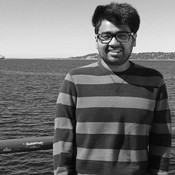Current Work
Data-Driven Dialog
Recently, I have been working on the problem of conversational systems that engage in full end-to-end dialog (as distinct from single-turn question-answering). In particular, the work I have been doing has focused on the following additional conditions: (a) goal-driven dialog; and (b) data-driven (learned) models. The idea is to build fully-encapsulated dialog agents that can operate with learned models of a domain to steer the conversation towards the resolution of problems. We have evaluated our systems and agents in the context of technical support for Ubuntu (please see publications for our latest reports).
Human-Agent Collaboration
My graduate research work was strongly centered around the theme of automated planning systems as mediators for human-machine and human-agent teams. This idea encapsulates two distinct technical challenges: first, planning formalisms must be made expressive enough to be able to represent real-world scenarios. Then the applications of interest must be modeled in order to use state-of-the-art planners that have been augmented with these extensions. My research statement elucidates on this idea.
Planning for Human-Robot Teaming
My Ph.D. thesis work centered around the problem of planning for human-robot teaming; that is, considering the automated planning issues involved when supporting the execution of a robot in cooperative scenarios that involve teaming up with humans. Specifically, the problem was to have a high-level task-planner control -- and plan for -- a robot that has to act in a constantly changing world.
Metrics
Documents
Google Scholar
Here is a link to my Google Scholar page, which has a handy (and current) citation count.
Recent News
- I am organizing a workshop at AAAI 2017
- I organized a workshop at IJCAI 2016
- I co-organized a tutorial at AAAI 2015
- Our AI-MIX system won the best demo award at ICAPS 2014!
- Some publicity for our work on Twitter
- Letter of commendation from the ASU President
Erdös Number
My Erdös Number is 3: William Cushing ⇄ Henry Kierstead ⇄ Paul Erdös
Internships
IBM TJ Watson Research Lab
In 2012, I interned at IBM's TJ Watson Research Laboratory in Hawthorne, NY. My work was related to streams, and automating the process of composing them and handling the entities and artifacts that are produced as a result of these compositions. We handled a network traffic monitoring application, and used planning tools and models to refine the security alerts that are escalated to a human administator, thus improving overall efficiency and reducing the response time to serious incidents.
IBM India Research Lab
I worked with IBM's India Research Lab in Bangalore (in 2011) on creating a model for road traffic and various intelligent sensors and systems that are part of the 'Internet of Things' (IoT). This model was used with planning systems to produce automated decisions on controlling the traffic in order to optimize metrics like throughput and wait time.
Service
Refereeing
- IJCAI 2017: Senior Program Committee
- ICAPS 2017: Program Committee
- WWW 2017: Program Committee
- IJCAI 2016: Senior Program Committee
- AAAI 2016: Program Committee
- AAAI 2015: Program Committee
- ICWSM 2015: Program Committee
- AAAI 2014: Program Committee
- ICWSM 2014: Program Committee
- WSDM 2014: Auxiliary Reviewer
- ACM Multimedia 2013: Program Committee
- CP4PS Workshop at AAAI 2012: Program Committee
- AAAI 2012: Auxiliary Reviewer
- TAMPRA Workshop at ICAPS 2012: Program Committee
- AAAI 2011: Auxiliary Reviewer
- ICAPS 2009: Auxiliary Reviewer
Organization
- ICAPS 2017: Organizing Committee, SPARK and UISP Workshops
- AAAI 2017: Lead Organizer, Human-Aware AI (HAAI) Workshop
- IJCAI 2016: Lead Organizer, Closing the Cognitive Loop (CogComp2016) Workshop
- AAAI 2015: Human-in-the-Loop Planning and Decision Support Tutorial
